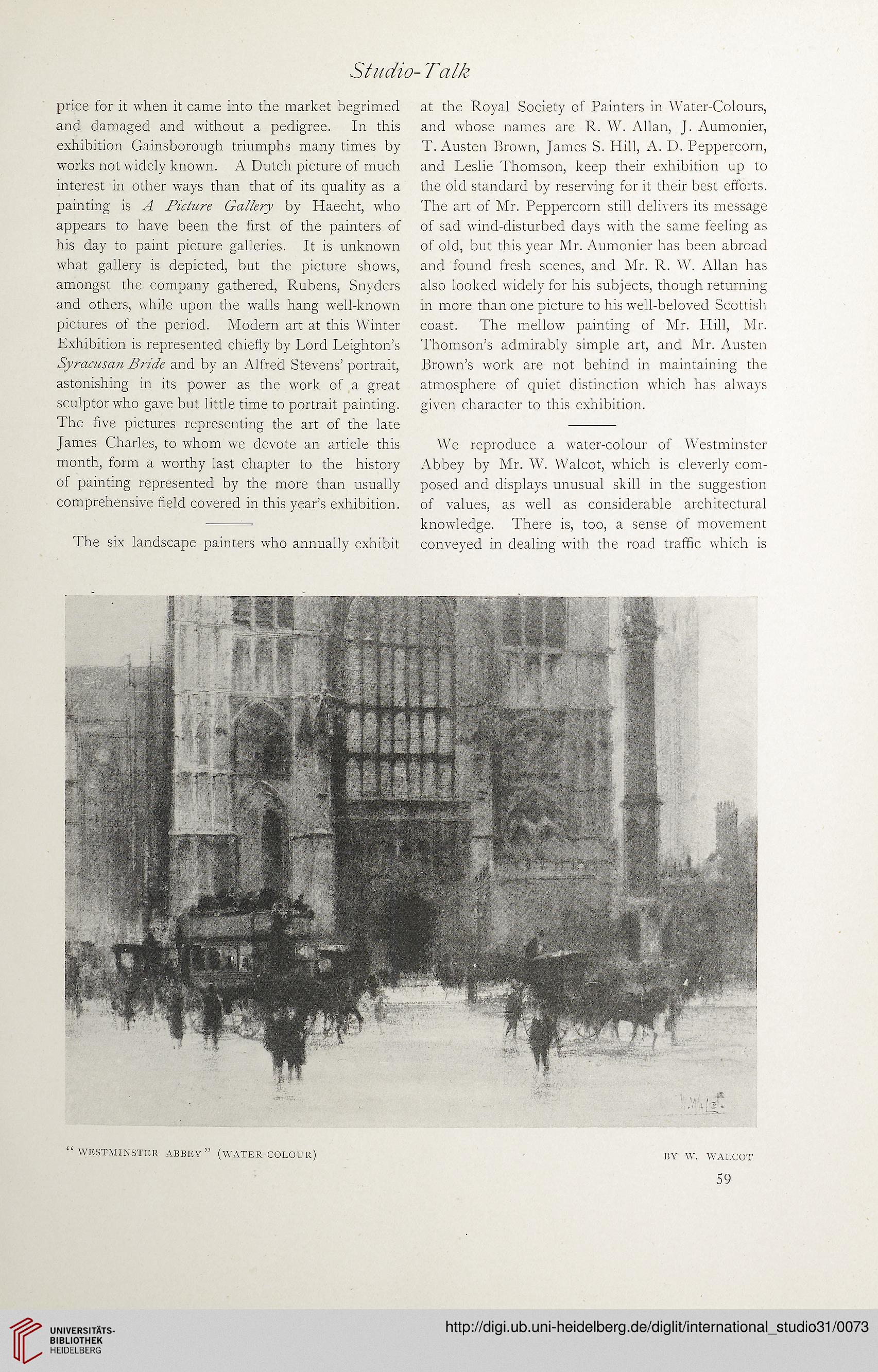Studio-Talk
price for it when it came into the market begrimed
and damaged and without a pedigree. In this
exhibition Gainsborough triumphs many times by
works not widely known. A Dutch picture of much
interest in other ways than that of its quality as a
painting is A Picture Gallery by Haecht, who
appears to have been the first of the painters of
his day to paint picture galleries. It is unknown
what gallery is depicted, but the picture shows,
amongst the company gathered, Rubens, Snyders
and others, while upon the walls hang well-known
pictures of the period. Modern art at this Winter
Exhibition is represented chiefly by Lord Leighton’s
Syracusan Bride and by an Alfred Stevens’ portrait,
astonishing in its power as the work of a great
sculptor who gave but little time to portrait painting.
The five pictures representing the art of the late
James Charles, to whom we devote an article this
month, form a worthy last chapter to the history
of painting represented by the more than usually
comprehensive field covered in this year’s exhibition.
The six landscape painters who annually exhibit
at the Royal Society of Painters in Water-Colours,
and whose names are R. W. Allan, J. Aumonier,
T. Austen Brown, James S. Hill, A. D. Peppercorn,
and Leslie Thomson, keep their exhibition up to
the old standard by reserving for it their best efforts.
The art of Mr. Peppercorn still delivers its message
of sad wind-disturbed days with the same feeling as
of old, but this year Mr. Aumonier has been abroad
and found fresh scenes, and Mr. R. W. Allan has
also looked widely for his subjects, though returning
in more than one picture to his well-beloved Scottish
coast. The mellow painting of Mr. Hill, Mr.
Thomson’s admirably simple art, and Mr. Austen
Brown’s work are not behind in maintaining the
atmosphere of quiet distinction which has always
given character to this exhibition.
We reproduce a water-colour of Westminster
Abbey by Mr. W. Walcot, which is cleverly com-
posed and displays unusual skill in the suggestion
of values, as well as considerable architectural
knowledge. There is, too, a sense of movement
conveyed in dealing with the road traffic which is
“WESTMINSTER ABBEY” (WATER-COLOUR)
BY W. WALCOT
59
price for it when it came into the market begrimed
and damaged and without a pedigree. In this
exhibition Gainsborough triumphs many times by
works not widely known. A Dutch picture of much
interest in other ways than that of its quality as a
painting is A Picture Gallery by Haecht, who
appears to have been the first of the painters of
his day to paint picture galleries. It is unknown
what gallery is depicted, but the picture shows,
amongst the company gathered, Rubens, Snyders
and others, while upon the walls hang well-known
pictures of the period. Modern art at this Winter
Exhibition is represented chiefly by Lord Leighton’s
Syracusan Bride and by an Alfred Stevens’ portrait,
astonishing in its power as the work of a great
sculptor who gave but little time to portrait painting.
The five pictures representing the art of the late
James Charles, to whom we devote an article this
month, form a worthy last chapter to the history
of painting represented by the more than usually
comprehensive field covered in this year’s exhibition.
The six landscape painters who annually exhibit
at the Royal Society of Painters in Water-Colours,
and whose names are R. W. Allan, J. Aumonier,
T. Austen Brown, James S. Hill, A. D. Peppercorn,
and Leslie Thomson, keep their exhibition up to
the old standard by reserving for it their best efforts.
The art of Mr. Peppercorn still delivers its message
of sad wind-disturbed days with the same feeling as
of old, but this year Mr. Aumonier has been abroad
and found fresh scenes, and Mr. R. W. Allan has
also looked widely for his subjects, though returning
in more than one picture to his well-beloved Scottish
coast. The mellow painting of Mr. Hill, Mr.
Thomson’s admirably simple art, and Mr. Austen
Brown’s work are not behind in maintaining the
atmosphere of quiet distinction which has always
given character to this exhibition.
We reproduce a water-colour of Westminster
Abbey by Mr. W. Walcot, which is cleverly com-
posed and displays unusual skill in the suggestion
of values, as well as considerable architectural
knowledge. There is, too, a sense of movement
conveyed in dealing with the road traffic which is
“WESTMINSTER ABBEY” (WATER-COLOUR)
BY W. WALCOT
59





